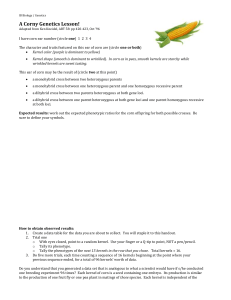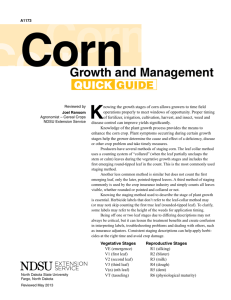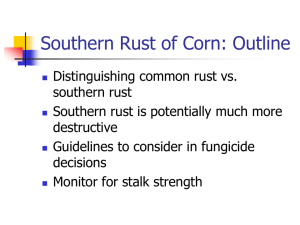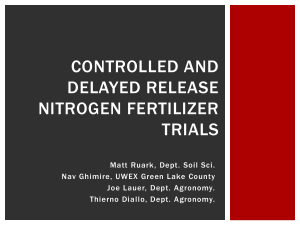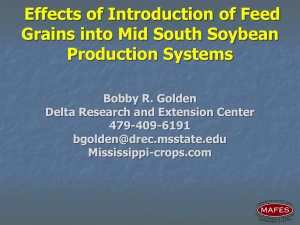Soybean Growth and Development
advertisement
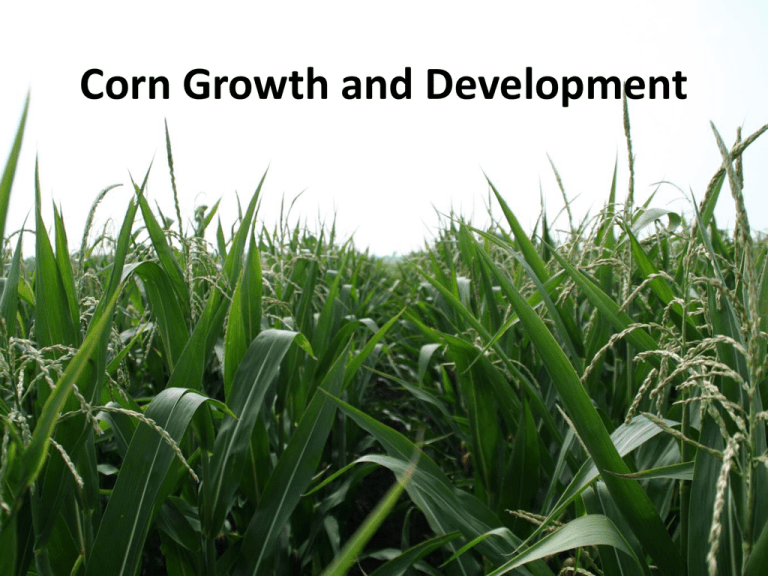
Corn Growth and Development Outline • • • • • Stress and yield loss Growth staging Vegetative stages Reproductive stages Conclusions Stress and crop yield loss • At each growth stage of corn, certain aspects of management must be considered. • Each stage has its own problems which may interfere with growth at that stage. • Problems include adverse soil conditions, weeds, insects, diseases, and other disorders. • Problems that occur early in the season may contribute to the yield loss experienced at the end of the season during harvest. • We will examine problems for the stages of corn throughout the growing season. Growth staging • Growth stages may overlap in a field • A growth stage for a field begins when at least 50 percent of the plants have reached or are beyond a certain stage. • The Corn Field Guide provides scouting information by growth stage for many diseases and insects of corn. Determining growth staging • Leaf collar method – The collar is where the leaf blade visually breaks away from the sheath and the stalk – The number of visible collars = vegetative growth stage (V stages) Determining growth staging • Leaf collar method – Leaves still in the whorl – DO NOT count these leaves – Leaves with a visible collar – COUNT these leaves Vegetative stages • Vegetative Stages - VE: Shoot emerges from soil - V1: Collar is visible on lowest leaf - V2: Collar is visible on two lowest leaves - V(n): Each successive collar visible - VT: Lowest branch of tassel visible, before silks VE - Emergence • VE: When the young shoot pushes through the soil surface • Problems to watch for: – – – – – Early and late planting Flooding, soil crusting Root rots Seed decay and seedling blight Seed corn maggot, white grubs, wireworms – Stewart’s disease, Goss’s wilt – Cutworms, slugs, billbugs, etc. VE V1 to V5 • First leaf has a rounded tip • All other leaves have pointed tips • The growing point is below ground • Between V1 and VT, a new leaf (growth stage) occurs every 4-5 days in May, 3-4 days in June, and 2-3 days in July V1 V1 to V5 • Problems to watch for: – – – – – – Flooding Stewart’s disease, Goss’s wilt, Anthracnose leaf spot Root rots, seedling blight Cutworms, slugs, billbugs, etc. Herbicide injury Weed escapes and excess weed competition © Marlin E. Rice V6 • V6 is one of the key stages for development – Growing point is above the soil surface – All leaves, ear shoots (approx. 8), and tassel are fully formed – Ear girth - number of rows around the ear is also determined • Problems to watch for during V6: – Eyespot, common smut, Stewart’s wilt – Stalk borer – Nutrient deficiencies V10+ • Stalks need to be split to stage – Need a larger knife & spade – Each leaf is attached to a specific node – Need to line up which leaf goes to which node on the stalk – Split lower stalk lengthwise to determine uppermost leaf node – Approximately < ¼ inch above the condensed area is the 5th node – First four nodes cannot be distinguished from one another – This method required until VT V10-VT • V10-VT – In late June and early July new leaves appear every 2-3 days – Hybrids & environment will cause variability in the total number of leaves • V12-VT – Ear length - number of kernels per row - is determined over a wide range of time, from approx. V7 to V15/V16, and can be reduced by stress – 750 to 1000 ovules form per ear. Average kernel number at harvest is 475 to 550 V10-VT • Problems to watch for: – Eyespot, Physoderma brown spot, common rust – Scout for nematodes – Corn rootworm adults begin emerging – Corn leaf aphid – Root lodging – Greensnap – Nutrient deficiencies – Grasshopper, armyworm – Goss’s wilt VT-Tasseling • Tasseling occurs when entire tassel is visible • Final vegetative stage • Occurs just prior to, or at the same time, as silking • The tassel produces pollen grains, shedding a half million per day per plant at the peak • Pollen shed for a field typically lasts for about a week VT • Problems to watch for during VT include: – Gray leaf spot, southern rust, northern leaf blight, and others – Corn earworm egg mass scouting and other insects – Corn rootworm damage to roots may really show now as lodging or nutrient deficiencies – Silking/pollen shed synchronization problems from drought/heat – Corn leaf aphids on tassel can throw off pollen shed Reproductive stages • Staging is no longer based on the vegetative appearance of the plant • Focus only on the ear to stage the plant & field • Look at kernels in the middle of the ear • Six reproductive stages total (soybean has eight) • Use number and names (Example: R1 = Silking) Reproductive stages • Reproductive Stages • • • • • R1 (silk): Any silk becomes visible outside the husk leaves R2 (blister): Small, white kernels, and kernel fluid is clear R3 (milk): Yellow kernels, milky white fluid in kernel R4 (dough): Paste-like, or dough, kernel contents R5 (dent): Kernels dent on the top due to starch accumulation • R6 (Physiological maturity): Physiological maturity with maximum dry matter accumulation. Black layer occurs after physiological maturity. R1 - Silking • At least 50% of plants have 1 or more silks emerged (use only uppermost ear) • Pollen grains will land on silks and if receptive, fertilization will occur. • Silks are viable and receptive to pollen for at least 5 days • The plant uses the most water per day (0.35 inches) during R1 – Very sensitive to stresses • Silks have highest water content among all parts of the corn plant • Drought causes silk elongation to slow down and pollen shed to speed up R1 - Silking • Problems to watch for during R1: – Drought – Corn rootworm adults – Japanese beetle – Corn earworm – Foliar diseases © Marlin E. Rice R2 – Blister stage • Occurs about 10-12 days after silking • Kernel is: – Visible and resembles a blister – Filled with clear fluid and embryo is barely visible – Approx. 85% moisture content • If severe stress occurs now or during R3, kernels can be aborted from the tip downward. • Kernel abortion will occur until the plant has a sufficient supply of carbohydrates for the remaining kernels. R3 – Milk stage • Occurs approx. 18-20 days after silking • Kernel is colored yellow with the inside containing ‘milky’ white fluid. Kernel moisture content is approx. 80% • Starch is beginning to accumulate in the kernel R4 – Dough stage • Occurs approx. 24-26 days after silking • Interior of kernel has thickened to a dough or paste-like substance • Kernel moisture content is approx. 70% and kernels may begin to dent at the base of the ear • Stresses will reduce kernel weight now R2-Blister to R4-Dough • Problems to watch for: – Foliar disease – Head smut – European corn borer – Grasshopper – Barren stalks, poor pollination – Nutrient deficiencies R5 – Dent stage • Occurs approx. 31-33 days after silking • Kernels dented in at top with the “milk line” separating the liquid and solid (starch) portions • Within R5, kernels are often staged according to the progression of the milk line; i.e. ¼, ½, and ¾ • Beginning of R5 - kernels have 60% moisture content • Stresses will reduce kernel weight now R6 – Physiological maturity • Occurs approx. 66-70 days after silking • R6 is reached after the milk line disappears and the starch has reached the base of the kernel • Kernels have reached maximum dry matter accumulation • Kernel moisture is about 35% at physiological maturity • Black layer occurs after physiological maturity, serving as a visual verification that the plant is mature; it typically occurs at 30% moisture but varies by hybrid and environment • Only external stress can reduce yield now, such as plant lodging or insect feeding R5-Dent to R6-Physiological maturity • Problems to watch for: – Ear rots – Stalk rots – Anthracnose top dieback – Stalk lodging – Abnormal ear fill which identifies periods of stress Conclusions • Certain management considerations must be taken into account during the various stages of corn growth. • Each stage has its own set of problems. • Many insects, diseases, and disorders are problems during multiple corn growth stages. • This knowledge can help growers to be aware of the potential problems of corn throughout the season.
